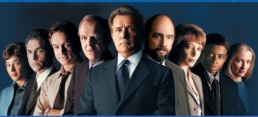Good storytellers drive market success.
But if you’re working on a big, multi-year project with thousands of people and lots of moving parts, or even if you’re part of a big corporate organization, it can be easy to feel like you and your work are disconnected from what your colleagues are doing.
You may find yourself halfway through the project asking, “How did I get here?” And, “WHY are we here anyway?”
If you’re starting to ask questions like that on the inside, chances are your customers and stakeholders on the outside have been asking them for months.
The best way to bind a big, complex corporate project together isn’t more meetings. It’s about being on the same page – almost literally – by understanding the story of your work.
Because stories are the best way to communicate WHY something matters and – as anyone who has studied Simon Sinek can tell you – the “why” of a project or company is what matters most.
“Because stories are the best way to communicate WHY something matters and – as anyone who has studied Simon Sinek can tell you – the “why” of a project or company is what matters most.”
That’s why, for big organizations, a strong core narrative is such a powerful business strategy.
Think about Taylor Swift.
Love her or hate her, Swift is an undeniably successful musician and has set a high standard for her tours.
In fact, her current Eras tour is projected to gross $2.2 billion in North American ticket sales alone.
But since 2021, she’s also been working on a long-term project to re-record her back catalogue so she can own her music. The story behind that activity is part of the secret to her success.
For any other artist, re-recording music that their audience has already heard wouldn’t be exciting. But every Swiftie from LA to London knows the story of Taylor’s dispute with her record label, with Scooter Braun, and about her fight to own her own work.
That’s a powerful narrative that has kept her fans engaged and driven all four re-recorded albums to the top of the Billboard 100.
You know who else keeps fans engaged through a big, overarching narrative? Sci-fi and fantasy franchises with expanded universes — like Star Wars or Marvel.
An expanded universe creates infinite possibilities for stories. A creative writer can take familiar characters and weave them into any narrative they please. It allows moviemakers and showrunnners to tell old stories in new ways, allowing the characters that have been so carefully constructed to guide the narrative from one format or story to the next.
But even though an expanded universe allows for endless creativity, studios are not going to sell tickets unless they’ve got a core narrative and common brand elements to tie it all together.
One of my favourite examples of this is Star Wars.
Everyone knows that there’s some stuff that makes Star Wars, well, Star Wars. There are your big set pieces like the Death Star, X-Wings, and Jedi.
But at its heart, Star Wars is a series of interconnected stories about power, balance, adventure and morality. That’s what binds Star Wars together. That’s also what’s behind its continued popularity nearly 50 years later.
“When everyone knows the core narrative, it creates a foundation for the project to thrive.”
The lesson from Taylor Swift and Star Wars is the same: when everyone knows the core narrative, it creates a foundation for the project to thrive.
And the more talented the storyteller, the more complex are the stories you can tell—and the more ways your organization can find success in the market.
Everyone has a story. Let us help you tell yours better than anyone else. Contact us today.
Image source: Star Wars graphic sourced from starwars.com
Jordan Ray
Principal and Senior Narrative Consultant at Curious Public.


